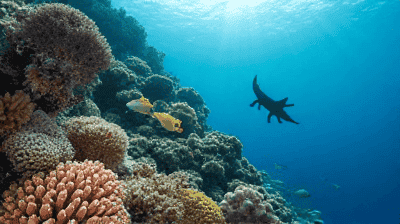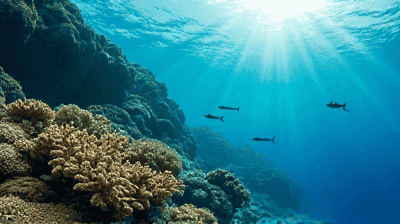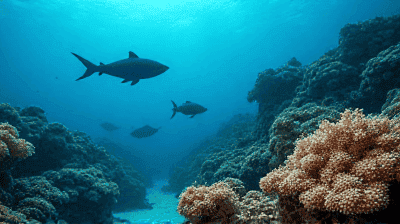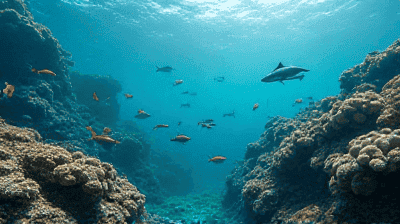
Coral reefs are one of the most diverse and productive ecosystems on the planet, often referred to as the "rainforests of the sea." These vibrant underwater structures support a staggering array of marine life, provide critical ecosystem services, and play a vital role in coastal protection and tourism-driven economies. However, coral reefs worldwide are facing unprecedented threats, leading to declining health and, in many cases, total ecosystem collapse. Climate change, overfishing, pollution, and ocean acidification are just a few of the factors contributing to the degradation of these invaluable ecosystems. In response to this crisis, innovative restoration techniques are being developed and implemented to save dying coral reefs.
Coral reefs are complex structures formed by colonies of tiny marine organisms known as corals. These organisms belong to the phylum Cnidaria and primarily consist of two main types: hard corals (scleractinians) and soft corals. Hard corals build the reef structure by secreting calcium carbonate, while soft corals provide additional habitat complexity without calcifying.
Coral reefs are typically found in warm, shallow waters, where sunlight can penetrate to support the photosynthetic algae, known as zooxanthellae, that live symbiotically within coral tissues. This relationship is crucial, as zooxanthellae provide corals with energy and nutrients, while corals offer a protected environment and access to sunlight.
Coral reefs are invaluable ecosystems that provide numerous ecological, economic, and social benefits:
Biodiversity Hotspots: Coral reefs support approximately 25 percent of all marine species, despite covering only 0.1 percent of the ocean floor. They are home to fish, invertebrates, mollusks, and various other organisms.
Coastal Protection: Healthy coral reefs act as natural barriers, absorbing wave energy and protecting coastlines from erosion and storm surges. This function is particularly important in the context of climate change and rising sea levels.
Fisheries Support: Coral reefs provide critical habitat for many commercially important fish species and support local fishing economies. Healthy reefs contribute to sustainable fisheries and food security for coastal communities.
Tourism and Recreation: Coral reefs attract millions of tourists each year for activities such as diving, snorkeling, and fishing, generating significant revenue for local economies.
Medicinal Potential: Many compounds derived from coral reef organisms have potential applications in medicine, including treatments for cancer and other diseases.

Coral reefs are increasingly vulnerable due to a combination of natural and anthropogenic stressors. The key threats to coral health include:
Climate change is perhaps the most significant threat to coral reefs. Rising sea temperatures lead to coral bleaching, a phenomenon where corals expel their symbiotic zooxanthellae due to stress. This loss of algae not only reduces the coral's vibrant color but also deprives it of essential nutrients, leading to weakened health and increased mortality rates.
As atmospheric carbon dioxide levels increase, more CO2 dissolves in ocean waters, leading to a decrease in pH (ocean acidification). This change in acidity affects corals' ability to calcify and build their skeletons, ultimately threatening the structural integrity of the entire reef.
Overfishing disrupts the balance of marine ecosystems and negatively impacts the health of coral reefs. Removing key species, such as herbivorous fish that graze on algae, allows algal blooms to proliferate, which can smother corals and hinder their growth.
Coastal development, agricultural runoff, and waste disposal introduce harmful pollutants into marine environments. Nutrient pollution can lead to algal blooms, while sedimentation from land-based activities can smother coral reefs, preventing sunlight from reaching them.
Physical destruction of coral habitats can occur through activities such as coastal development, dredging, and destructive fishing practices. These actions can lead to significant loss of coral cover and biodiversity.
In light of the severe threats facing coral reefs, researchers, conservationists, and communities are developing and implementing innovative restoration techniques to aid in their recovery. These approaches vary widely, depending on the specific challenges and local conditions. Below are some of the most promising restoration methods currently in use.
Coral gardening is a technique that involves collecting fragments of coral from healthy populations and growing them in nurseries. Once they reach a certain size, the corals are transplanted back onto degraded reefs. This method allows for the propagation of resilient coral species and contributes to coral cover recovery.
Microfragmentation involves cutting coral colonies into smaller pieces, or microfragments, and allowing them to grow in a controlled environment. This technique promotes faster growth rates due to increased surface area and reduces competition with algae. Microfragmentation has been successfully used to restore various coral species.
Assisted gene flow (AGF) aims to introduce genetically resilient coral populations to areas that have experienced significant decline. By moving coral larvae or fragments from healthy populations, researchers can enhance genetic diversity and increase the likelihood of survival under changing environmental conditions.
Artificial reefs are structures placed in marine environments to provide habitat for various marine species. By creating new surfaces for coral attachment, artificial reefs can promote the growth of corals and other marine life in areas where natural reefs have been damaged.
Recent research has explored the use of probiotics to enhance coral health and resilience. Probiotics consist of beneficial microorganisms that can be introduced to coral systems to improve overall health and resistance to stressors such as disease and bleaching.
An essential component of any coral restoration effort is rigorous monitoring and adaptive management. Researchers must continuously assess the effectiveness of restoration techniques and adapt strategies based on the outcomes.

Several innovative restoration projects worldwide demonstrate the potential for successful coral reef recovery through proactive measures. Here are a few notable examples:
The Coral Triangle Initiative, involving Indonesia, Malaysia, the Philippines, Papua New Guinea, the Solomon Islands, and Timor-Leste, aims to protect the marine biodiversity of the Coral Triangle region. Various restoration techniques, including coral gardening and community engagement, have been implemented to enhance coral resilience and promote sustainable livelihoods.
In Australia, the Great Barrier Reef Restoration Program encompasses multiple restoration projects designed to combat the impacts of climate change and human activities. Techniques such as microfragmentation and coral gardening have been used to restore damaged areas and improve the overall health of the reef.
The Reef Restoration Foundation, based in Queensland, Australia, focuses on growing and transplanting corals using the coral gardening technique. Volunteers actively participate in restoration efforts, fostering community engagement while rehabilitating damaged reef habitats.
The Ocean Agency advocates for the conservation and restoration of coral reefs through various innovative projects, including coral gardening and monitoring efforts. Their work emphasizes collaboration between scientists, corporations, and local communities to drive meaningful change.
Hawaii has witnessed several successful coral restoration initiatives, including the use of assisted gene flow to enhance genetic diversity in vulnerable coral populations. Community involvement and education are integral components of these projects, as local residents work to restore their cherished reefs.
Community involvement is critical to the success of coral restoration efforts. Engaging local residents and stakeholders promotes stewardship, increases awareness of the value of healthy coral reefs, and fosters collaboration in restoration activities.
Educational programs targeting local communities can raise awareness about the importance of coral reefs and the challenges they face. Workshops, seminars, and hands-on training can empower community members to participate actively in restoration efforts.
Many restoration projects rely on volunteers to assist with activities such as coral planting, monitoring, and data collection. Hands-on involvement allows individuals to connect with their environment and develop a deeper understanding of ecological processes.
Incorporating indigenous knowledge and traditional practices into restoration efforts can enhance the effectiveness of projects. Local communities often have valuable insights into the historical conditions of coral reefs and sustainable management practices.
Engaging stakeholders in decision-making processes ensures that restoration strategies align with community needs and values. Collaborative governance promotes buy-in from local residents and fosters a sense of ownership over restoration efforts.

Despite the promising advancements in coral reef restoration techniques, several challenges persist:
The ongoing effects of climate change, including rising sea temperatures and ocean acidification, pose significant challenges to the success of restoration efforts. While innovative techniques can enhance coral resilience, they may not fully mitigate the impacts of a rapidly changing climate.
Many restoration projects operate on limited budgets and rely on volunteer efforts, making it challenging to scale up successful initiatives. Securing funding and resources is crucial to sustaining long-term restoration programs.
Successful restoration requires specialized knowledge and technical expertise. Building capacity among local communities and stakeholders is essential to ensure that restoration efforts are effective and sustainable.
Continuous monitoring of coral health and restoration success is crucial; however, it can be resource-intensive and logistically challenging. Developing cost-effective and efficient monitoring techniques is vital for the long-term success of restoration projects.
The future of coral reef restoration holds promise as researchers, conservationists, and communities continue to innovate and collaborate. Key areas of focus for advancing restoration efforts include:
Ongoing research into coral biology, genetics, and ecosystem dynamics will provide valuable insights for improving restoration techniques. Developing new technologies and methodologies can enhance our ability to restore and sustain coral reefs.
International collaboration and knowledge sharing are essential for addressing the complex challenges facing coral reefs. By working together, countries and organizations can develop best practices and share lessons learned.
Ultimately, addressing the root causes of climate change is critical for the long-term success of coral reef restoration. Mitigation efforts, including reducing greenhouse gas emissions and promoting sustainable practices, are essential for safeguarding coral ecosystems.
Supportive policies and funding mechanisms for coral reef conservation and restoration initiatives can help scale up successful projects. Governments, NGOs, and the private sector must prioritize restoration efforts and recognize the importance of healthy coral reefs for sustainable development.
Raising public awareness about the importance of coral reefs and the threats they face can drive community engagement and advocacy. Empowering individuals to take action and support restoration efforts contributes to a collective commitment to protecting these vital ecosystems.
Coral reefs face unprecedented challenges, but innovative restoration techniques offer hope for the revival of these essential ecosystems. By harnessing the power of community involvement, cutting-edge research, and global collaboration, we can work toward restoring dying coral reefs and ensuring their survival for future generations. The combined efforts of scientists, conservationists, local communities, and policymakers will be crucial in securing a brighter future for coral reefs around the world.
Through ongoing commitment to restoration and conservation, we can protect these vibrant underwater ecosystems and the myriad of life they support, ultimately contributing to the health of our oceans and the planet as a whole.